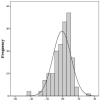With others or alone? Adolescent individual differences in the context of smoking lapses
- PMID: 25664557
- PMCID: PMC4530102
- DOI: 10.1037/hea0000211
With others or alone? Adolescent individual differences in the context of smoking lapses
Abstract
Objective: Although a great deal of adolescent smoking research has investigated predictors of initiation, much less has focused on predictors of lapsing during a quit attempt. In particular, the role of social context may deserve greater attention in models of adolescent smoking cessation. Therefore, the present investigation aimed to use ecological momentary assessment (EMA) to examine individual differences in social lapsing--the extent to which lapses occur around others versus when alone.
Methods: Analyses focused on 179 adolescent smokers (aged 14-18 years) engaged in an unassisted quit attempt. There were 2 general EMA assessment intervals: prequit (1 week) and postquit (2 weeks). Participants reported every time that they smoked a cigarette and at random, nonsmoking times; in each assessment, participants responded to questions about their current environment, behaviors, and psychological state. A 3-month follow-up assessed longer-term smoking-related outcomes.
Results: Consistent with other adolescent research, the overall rate of lapsing was very high (93%). Social lapsing rates were likewise high (among those who lapsed, 73% reported their first lapse was social), but they also varied continuously across individuals. We computed a social lapsing coefficient for each youth and found that it related to smoking factors at baseline (e.g., lower smoking intensity and dependence) and follow-up (e.g., lower cotinine levels).
Conclusions: These results suggest that higher rates of social lapsing are associated with being a lighter, less dependent smoker and having better eventual cessation prospects. Findings provide evidence that accounting for variability in social lapsing may improve theory and treatment.
(c) 2015 APA, all rights reserved).
Figures



Similar articles
-
Predictors of smoking lapse during a 48-hour laboratory analogue smoking cessation attempt.Psychol Addict Behav. 2017 Jun;31(4):415-422. doi: 10.1037/adb0000246. Epub 2017 Jan 26. Psychol Addict Behav. 2017. PMID: 28125243
-
Predicting Smoking Lapses in the First Week of Quitting: An Ecological Momentary Assessment Study.J Addict Med. 2018 Jan/Feb;12(1):65-71. doi: 10.1097/ADM.0000000000000365. J Addict Med. 2018. PMID: 29068827 Free PMC article.
-
Ecological momentary assessment of adolescent smoking cessation: a feasibility study.Nicotine Tob Res. 2008 Jul;10(7):1185-90. doi: 10.1080/14622200802163118. Nicotine Tob Res. 2008. PMID: 18629728 Free PMC article.
-
Early lapses in a cessation attempt: lapse contexts, cessation success, and predictors of early lapse.Nicotine Tob Res. 2013 Nov;15(11):1883-91. doi: 10.1093/ntr/ntt074. Epub 2013 Jun 18. Nicotine Tob Res. 2013. PMID: 23780705 Free PMC article. Clinical Trial.
-
Conceptualizing analyses of ecological momentary assessment data.Nicotine Tob Res. 2014 May;16 Suppl 2(Suppl 2):S76-87. doi: 10.1093/ntr/ntt195. Epub 2013 Dec 9. Nicotine Tob Res. 2014. PMID: 24323571 Free PMC article. Review.
Cited by
-
Tracking Young Adults' Attitudes Toward Tobacco Marketing Using Ecological Momentary Assessment (EMA).Subst Use Misuse. 2017 Jul 29;52(9):1219-1224. doi: 10.1080/10826084.2017.1302958. Epub 2017 Jun 12. Subst Use Misuse. 2017. PMID: 28605315 Free PMC article.
-
Research on Youth and Young Adult Tobacco Use, 2013-2018, From the Food and Drug Administration-National Institutes of Health Tobacco Centers of Regulatory Science.Nicotine Tob Res. 2020 Jun 12;22(7):1063-1076. doi: 10.1093/ntr/ntz059. Nicotine Tob Res. 2020. PMID: 31127298 Free PMC article. Review.
-
Affect, craving, and cognition: An EMA study of ad libitum adolescent smoking.Psychol Addict Behav. 2018 Sep;32(6):583-594. doi: 10.1037/adb0000392. Psychol Addict Behav. 2018. PMID: 30211581 Free PMC article.
-
Individual variation in the attribution of incentive salience to social cues.Sci Rep. 2020 Feb 13;10(1):2583. doi: 10.1038/s41598-020-59378-5. Sci Rep. 2020. PMID: 32054901 Free PMC article.
-
Ecological Momentary Assessment with smartphones for measuring mental health problems in adolescents.World J Psychiatry. 2016 Sep 22;6(3):303-10. doi: 10.5498/wjp.v6.i3.303. eCollection 2016 Sep 22. World J Psychiatry. 2016. PMID: 27679769 Free PMC article.
References
-
- Ashton H, Stepney R. Smoking: Psychology and pharmacology. Tavistock Publications; New York: 1982.
-
- Bliss RE, Garvey AJ, Ward KD. Resisting temptations to smoke: Results from within-subjects analyses. Psychology of Addictive Behaviors. 1999;13(2):143.
Publication types
MeSH terms
Grants and funding
LinkOut - more resources
Full Text Sources
Other Literature Sources
Medical
Research Materials

